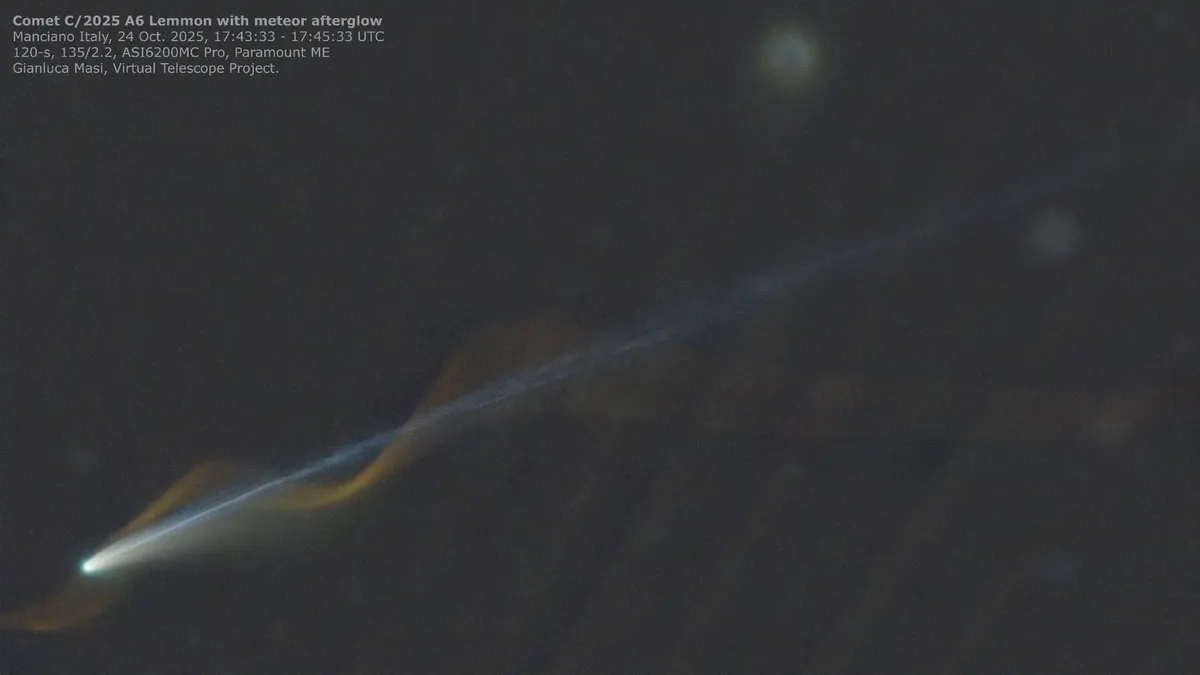
Astronomer Gianluca Masi achieved a remarkable feat on October 24 by capturing spectacular footage of a glowing meteor trail encircling the colossal tail of Comet Lemmon. This captivating event took place as the wandering solar system body approached the constellation Serpens Caput in the night sky over Earth. Just before Masi snapped a two-minute exposure of Comet Lemmon using an astrographic camera operated by the Virtual Telescope Project in Manciano, Italy, a bright meteor streaked across the sky.
The meteor made its appearance shortly before Masi captured the image at 1:43 p.m. EDT (17:43 GMT) on October 24. His photograph revealed the stream of ionized gas left in the meteor's wake, which rapidly expanded and rose into the upper atmosphere, creating a visually stunning wave effect. This effect appeared to wrap around Comet Lemmon's tail from our perspective on Earth.
Masi’s image also showcased a subtle fan-like pattern rippling across the photograph, resulting from wayward light impacting the camera sensor. According to Masi, this phenomenon is linked to the ionization of molecular oxygen in the atmosphere, a process triggered by the meteor event. Following this ionization, the recombination of molecules produces light emissions at specific wavelengths. Under ideal conditions, these glowing trails can even appear to form spirals in the upper atmosphere.
Despite the seemingly intertwined appearance of the meteor's afterglow and Comet Lemmon's tail in Masi’s photo, he clarifies that they are, in fact, quite distant from each other. The meteor's afterglow appears to coil around the comet's ion tail—a stunning visual illusion—since the meteor was an atmospheric effect induced by the meteor itself, while Comet Lemmon was approximately 100 million kilometers away at the time.
Masi also shared a breathtaking timelapse of the event, captured between 1:37 p.m. (17:37 GMT) and 2:12 p.m. (18:12 GMT) on October 24. This timelapse showcases the meteor's ion trail twisting around Comet Lemmon, while satellites left streaking trails across the image frames, contributing to the overall spectacle.
Since its discovery in January of this year, Comet Lemmon has significantly brightened and is currently estimated to have a magnitude of approximately +4.2, according to the Comet Observation database (COBS) managed by the Crni Vrh Observatory in Slovenia. The magnitude scale measures the apparent brightness of celestial objects, with lower numbers indicating brighter objects. This means that under dark sky conditions, it is possible to spot Comet Lemmon as a dim, hazy patch of light. However, using a pair of 10X50 binoculars or a backyard telescope can greatly enhance visibility.
As October draws to a close, Comet Lemmon is observed moving away from the constellation Serpens Caput towards the constellation Ophiuchus, also known as the serpent-bearer. This celestial journey is noteworthy as the comet approaches its closest point to the sun on November 8, presenting an excellent opportunity for skywatchers to observe this fascinating cosmic phenomenon.